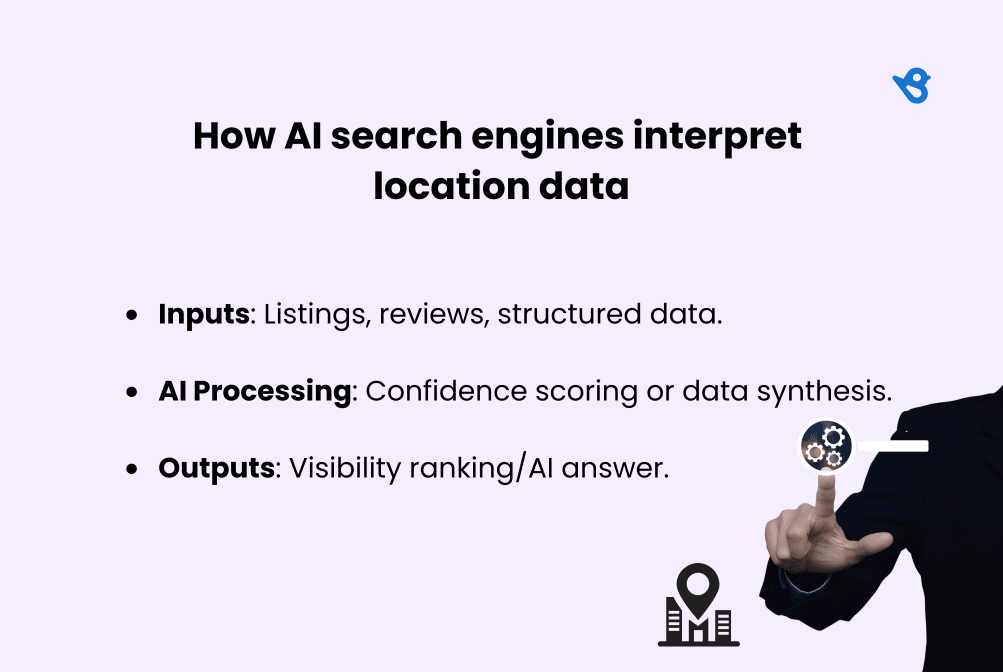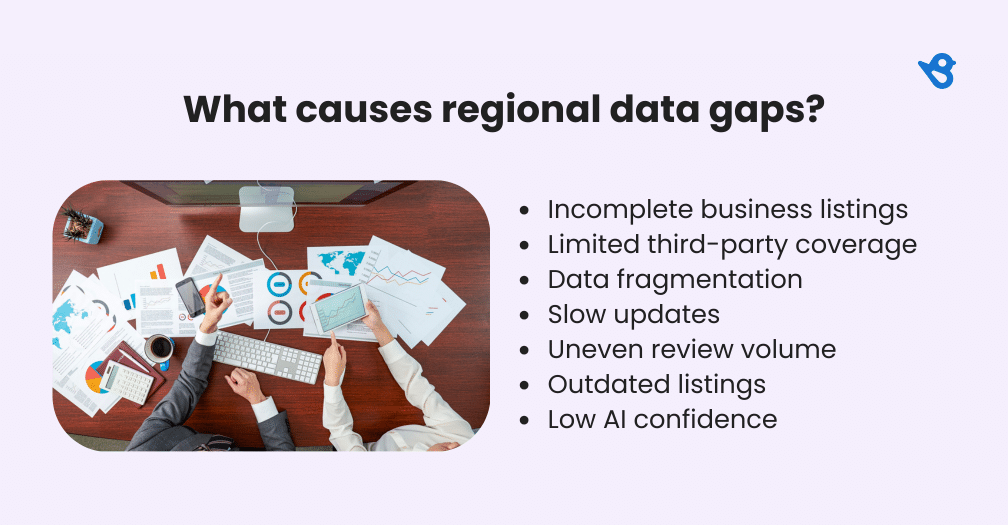Regional data gaps in AI search occur when business information across locations is incomplete, inconsistent, or outdated, making some branches visible while others stay hidden in customer searches.
Summary
AI-powered search is redefining how customers discover brands. But when business data is missing or inconsistent, some locations appear in results while others disappear. These gaps often stem from outdated listings, low review volume, and fragmented location data, and are amplified by uneven global coverage in AI models. For multi-location enterprises, the consequences are serious: lower visibility, lost trust, and missed revenue. This blog explains what causes these gaps and how to fix them through stronger data governance, automation, local review management, and predictive visibility, so every location can be found accurately in AI-powered search worldwide.
Table of contents
- Summary
- What are the data gaps in AI search?
- How AI search engines interpret location data
- How do regional data gaps reduce brand visibility and conversions?
- Why data gaps put multi-location brands at risk
- Why regional data gaps happen and why they persist
- Enterprise strategies to fix regional data gaps at scale
- Real-world results: How brands closed regional data gaps
- Future-proofing AI visibility with predictive strategies
- FAQs
- How Birdeye helps brands close regional data gaps
What are the data gaps in AI search?
Regional data gaps occur when AI search engines lack accurate, complete, and consistent information for all locations of a brand. The result is uneven visibility, even when the business operates in every market.
These gaps are often more pronounced in regions with weaker digital infrastructure, limited open datasets, or stricter data privacy laws. In many developing or highly regulated markets, AI systems often have fewer reliable signals to learn from, leading to weaker visibility for even well-established brands.
In practice, this can look like:
- Inconsistent hours or addresses across cities
- Missing product or service details in certain states
- Sparse or outdated reviews in smaller markets
AI systems rely on these local signals to determine relevance. When the data is incomplete, the algorithm simply skips that location.
For example, a national restaurant chain may have fully optimized profiles in New York, but in Des Moines, incomplete details mean a customer searching for “gluten-free pizza near me” never sees that location, even if it is offered.
These gaps usually form when corporate, franchise, and third-party data sources are not synchronized. They are also more common in lower-volume markets where AI systems receive fewer signals to trust.
These data gaps arise from how AI systems read and rank business information.
How AI search engines interpret location data
AI search engines synthesize multiple signals, like structured business data, customer reviews, and local listings, to deliver precise, conversational answers. They measure “data confidence,” prioritizing sources that appear complete, consistent, and frequently updated. When even a single signal (such as hours, address, or reviews) is missing or inconsistent, AI confidence drops, reducing the brand’s visibility in AI results.
In simple terms, the more trustworthy and up-to-date your local data, the higher your chances of appearing in AI-powered search results.

How do regional data gaps reduce brand visibility and conversions?
When AI systems lose confidence in a brand’s data, the effects go beyond search rankings. They impact visibility, customer trust, and revenue.
Regional data gaps don’t just create minor inconsistencies. They directly weaken a brand’s presence in AI-powered search, and that impact multiplies at scale.
Here’s how:
- Uneven visibility: Some locations dominate local results while others remain invisible.
- Customer frustration: Conflicting hours, phone numbers, or reviews quickly erode trust.
- Lost conversions: When a competitor’s data is more complete, AI engines choose them instead.
Take healthcare as an example. A clinic network may rank prominently in Dallas because its listings, hours, and reviews are consistent. But in nearby smaller towns, outdated numbers or thin reviews make those same clinics disappear from results. Patients searching locally assume the brand isn’t available, or worse, that it’s unreliable.
The outcome is uneven business performance. One region thrives while another struggles, not because of service quality, but because of missing signals in AI search.
Why data gaps put multi-location brands at risk
For leaders managing multi-location businesses, regional data gaps are not small technical glitches; they are enterprise risks that directly impact revenue, efficiency, and brand perception.
When customers see incomplete or conflicting information, they don’t stop to verify it. They simply assume the brand is unavailable or unreliable and move on to a competitor whose data looks more consistent.
This translates into:
- Missed conversions: A “closed” label on a location that’s actually open means lost walk-ins or calls.
- Broken expectations: National promises like “every branch offers same-day service” fall apart when local profiles say otherwise.
- Erosion of trust: Inconsistencies online make customers question reliability offline.
The risks extend beyond customer interactions:
- Brand dilution: When different locations show different versions of the brand online, overall credibility suffers.
- Revenue loss: Inaccurate or invisible profiles reduce calls, bookings, and visits, especially in competitive markets.
- Inefficient marketing spend: National campaigns assume visibility is uniform, but underperforming regions drag down ROI.
- Missed intelligence: Without consistent coverage, leaders lack a clear view of how the brand is performing in AI search.
For CMOs and CXOs, the cost of inaction leads to higher acquisition costs, a shrinking share of voice, and competitors seizing market visibility that should belong to them.
Why regional data gaps happen and why they persist
Understanding why AI search results vary across regions starts with how data is collected and updated. It’s rarely just one missing detail; it’s the accumulation of many small breakdowns that create uneven visibility.
Common causes of regional data gaps include:
- Incomplete local listings: Some locations update regularly, while others lag behind, leaving outdated hours or addresses in results.
- Limited third-party coverage: Smaller markets often lack reviews, local content, or media mentions.
- Data fragmentation: Information spread across corporate databases, franchise systems, and outdated directories doesn’t sync with AI.
- Slow updates: Even when changes are made, AI engines may take weeks or months to recognize them.
- Uneven review volume: High-traffic markets generate abundant reviews, while smaller ones appear less trustworthy to AI.
- Outdated listings: Phone numbers, services, or hours drift over time without central oversight.
- Low AI confidence: Sparse signals reduce the likelihood that engines display those locations.

Beyond these operational issues, deeper structural factors reinforce these disparities. Many AI models are trained primarily on Western or English-language data, limiting their exposure to smaller or non-English markets. This creates “data deserts,” where local businesses in regions with fewer digital footprints or less structured content are underrepresented in AI systems.
As a result, even brands that maintain accurate data may still be overlooked because the underlying AI training data lacks comparable regional context. The result? Even well-run operations can look weak online, not because of service quality, but because the underlying data isn’t synchronized or complete.
Enterprise strategies to fix regional data gaps at scale
These visibility gaps can’t be solved piecemeal. Fixing them requires enterprise-grade systems and workflows built for scale. Leaders can close these gaps and restore AI confidence by combining stronger data governance, structured content, and consistent customer signals.
1. Ensure customers can always find you
Uniform listings improve customer acquisition by making every branch equally visible in AI-powered search.
- Keep Name, Address, and Phone (NAP) details identical across Google Business Profile, Apple Maps, Yelp, and industry directories.
- Use automation to prevent drift over time.
2. Boost AI confidence in your brand
The more clearly AI can parse your data, the more often it surfaces your locations.
- Use schema markup (LocalBusiness, FAQ, Review) so AI engines interpret details with confidence.
- Present information in lists, Q&As, and tables, formats AI systems prefer to surface directly.
3. Strengthen reputation signals
Customers—and AI—trust locations with active, consistent reviews, no matter the region. More balanced reputation signals mean stronger visibility and higher conversions across regions.
- Encourage reviews in every region, not just flagship locations.
- Respond consistently to demonstrate engagement.
- Benchmark review volume and sentiment to uncover weak spots in smaller markets.
4. Use AI as a supervised assistant
AI can accelerate local updates and responses, but only when paired with human oversight. This ensures accuracy, brand voice, and customer trust at scale.
- Deploy AI to draft local updates, FAQs, or responses.
- Always add human oversight to maintain accuracy and brand voice.
- Treat AI as a scaling tool, not an autonomous manager.
5. Redefine KPIs for AI visibility
Traditional KPIs miss how brands appear in AI-driven discovery. Tracking AI visibility ensures leaders spot gaps before they cost revenue.
- Track how often your brand is cited in AI Overviews and answer engines.
- Monitor local share of voice across platforms like ChatGPT, Gemini, and Perplexity.
- Create a “regional data integrity score” to flag and correct inconsistencies early.
Together, these strategies transform fragmented location data into a single, trusted system of truth, helping every location appear accurately wherever customers search.
Real-world results: How brands closed regional data gaps
When brands close regional data gaps, the impact is immediate and measurable. These examples show how consistent data and review management directly improve AI visibility and customer engagement.
Moss & Company: Restoring consistency across 300+ properties

The California-based property management firm struggled with fragmented Google Business Profiles. Inconsistent phone numbers, addresses, and hours created confusion for both customers and AI search engines.
By centralizing location data management with Birdeye, Moss & Company eliminated inconsistencies and rebuilt trust signals. The results were immediate:
- 761% increase in map views
- 218% increase in search views
- 259% increase in phone calls
- 290% increase in website visits
- 222% increase in directions

Total Point Healthcare: Unlocking growth through reviews

With more than 20 clinics across Texas, Total Point Healthcare faced another challenge: uneven review volume. Some clinics looked credible, while others appeared invisible online.
After adopting Birdeye’s review management system, they generated a steady, consistent flow of reviews across every clinic. This lifted both visibility and patient acquisition:
- 486% increase in reviews
- 25,300 phone calls generated from search
- 62,500 Google profile impressions
- 21,400 website visits

These results prove that fixing data inconsistencies, whether in listings or reviews, directly improves AI visibility, improves trust, and drives measurable business growth.
Future-proofing AI visibility with predictive strategies
AI-powered discovery is still evolving, but one thing remains clear: brands that manage their data at scale consistently win visibility and trust. Multi-location enterprises can’t afford to treat AI search as a side project; it must be built into core operations.
The next stage of maturity involves moving brands from reactive to predictive visibility:
- Reactive: Correcting errors only after customers or teams flag them.
- Standardized: Using automation and governance frameworks to maintain accuracy across hundreds of locations.
- Predictive: Proactively monitoring share of voice in AI search, tracking regional accuracy scores, and fixing issues before they impact visibility.
Brands that achieve predictive visibility don’t just solve today’s problems; they anticipate tomorrow’s. They are better positioned to appear in AI Overviews, answer engines, and the next generation of discovery platforms.
As AI search evolves, global equity in data representation will become critical. Ensuring fair visibility will require collaboration not just from brands, but also from platforms and policymakers. Together, they can help AI discovery reflect real-world diversity, not just the regions with the most data or digital infrastructure.
The takeaway is simple: local accuracy fuels global success. By prioritizing consistency, credibility, and context in every market, multi-location brands secure a lasting competitive edge in the AI era.
FAQs
They are missing or inconsistent location details, such as hours, addresses, or services, that cause AI engines to show incomplete or uneven results across different regions.
Customers rely on AI answers to decide quickly. If data is wrong or missing, they assume the brand is unavailable and choose a competitor instead.
They occur when corporate, franchise, and third-party data sources are not aligned, or when smaller markets generate fewer reviews and engagement signals for AI to trust.
Solutions include standardizing location data, using schema markup, accelerating reviews, automating updates, and monitoring visibility by region.
It’s a proactive approach where brands track AI share of voice and accuracy scores, resolving issues before they affect search visibility.
Reviews act as trust signals. Locations with consistent, recent, and positive reviews appear more prominently in AI-powered search results.
How Birdeye helps brands close regional data gaps
Managing hundreds or thousands of locations across different markets takes more than local SEO; it requires unified, AI-ready data.
Birdeye’s AI-powered platform helps multi-location brands eliminate inconsistencies, strengthen visibility, and build trust across every digital touchpoint.
Here’s how Birdeye’s key solutions work together to close regional data gaps:
- Birdeye Search AI:
See how your brand appears across AI-powered search experiences like ChatGPT, Gemini, Perplexity, and Google. Identify missing or inaccurate information, such as hours, phone numbers, or website links, and get clear, location-specific recommendations to fix them. Search AI helps brands “be the answer” in the new era of generative discovery. - Birdeye Listings:
Keep every location’s details consistent across Google, Apple Maps, Yelp, Facebook, and hundreds of directories. Automated synchronization prevents drift and ensures customers and AI engines always see accurate, up-to-date business information everywhere. - Birdeye Reviews:
Collect, manage, and respond to reviews from every branch in one place. Balanced review volume and consistent engagement strengthen trust signals that boost visibility in both AI search and traditional search results. - Birdeye Insights AI:
Turn customer feedback, visibility trends, and performance data into actionable intelligence. Insights AI analyzes patterns across regions, helping leaders pinpoint weak spots, measure brand health, and make faster, data-driven decisions.
Together, these tools provide enterprises with a single source of truth for every location, helping them remain discoverable, credible, and competitive in AI-driven search results worldwide.
Watch a free demo to see how Birdeye can help your brand close data gaps and win visibility in every market.

Originally published









